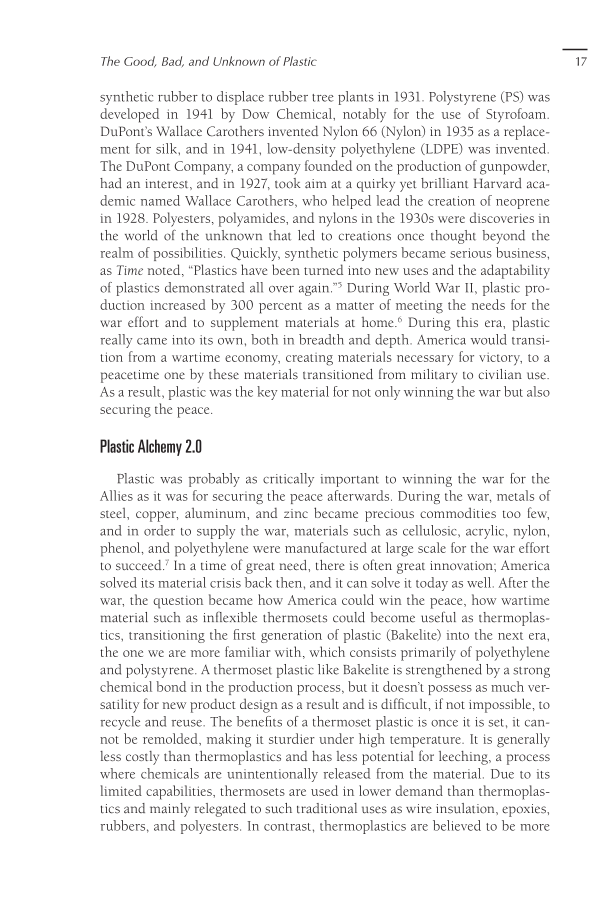The Good, Bad, and Unknown of Plastic 17 synthetic rubber to displace rubber tree plants in 1931. Polystyrene (PS) was developed in 1941 by Dow Chemical, notably for the use of Styrofoam. DuPont’s Wallace Carothers invented Nylon 66 (Nylon) in 1935 as a replace- ment for silk, and in 1941, low-density polyethylene (LDPE) was invented. The DuPont Company, a company founded on the production of gunpowder, had an interest, and in 1927, took aim at a quirky yet brilliant Harvard aca- demic named Wallace Carothers, who helped lead the creation of neoprene in 1928. Polyesters, polyamides, and nylons in the 1930s were discoveries in the world of the unknown that led to creations once thought beyond the realm of possibilities. Quickly, synthetic polymers became serious business, as Time noted, “Plastics have been turned into new uses and the adaptability of plastics demonstrated all over again.”5 During World War II, plastic pro- duction increased by 300 percent as a matter of meeting the needs for the war effort and to supplement materials at home.6 During this era, plastic really came into its own, both in breadth and depth. America would transi- tion from a wartime economy, creating materials necessary for victory, to a peacetime one by these materials transitioned from military to civilian use. As a result, plastic was the key material for not only winning the war but also securing the peace. Plastic Alchemy 2.0 Plastic was probably as critically important to winning the war for the Allies as it was for securing the peace afterwards. During the war, metals of steel, copper, aluminum, and zinc became precious commodities too few, and in order to supply the war, materials such as cellulosic, acrylic, nylon, phenol, and polyethylene were manufactured at large scale for the war effort to succeed.7 In a time of great need, there is often great innovation America solved its material crisis back then, and it can solve it today as well. After the war, the question became how America could win the peace, how wartime material such as inflexible thermosets could become useful as thermoplas- tics, transitioning the first generation of plastic (Bakelite) into the next era, the one we are more familiar with, which consists primarily of polyethylene and polystyrene. A thermoset plastic like Bakelite is strengthened by a strong chemical bond in the production process, but it doesn’t possess as much ver- satility for new product design as a result and is difficult, if not impossible, to recycle and reuse. The benefits of a thermoset plastic is once it is set, it can- not be remolded, making it sturdier under high temperature. It is generally less costly than thermoplastics and has less potential for leeching, a process where chemicals are unintentionally released from the material. Due to its limited capabilities, thermosets are used in lower demand than thermoplas- tics and mainly relegated to such traditional uses as wire insulation, epoxies, rubbers, and polyesters. In contrast, thermoplastics are believed to be more
Document Details My Account Print multiple pages
Print
You have printed 0 times in the last 24 hours.
Your print count will reset on at .
You may print 0 more time(s) before then.
You may print a maximum of 0 pages at a time.
































































































































































